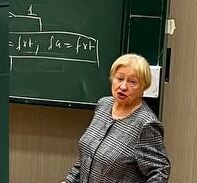ВКР - Математическая модель задержек поездов (1222229), страница 11
Текст из файла (страница 11)
From (1.18) and (1.79) it follows that
 (1.84)
(1.84)
where
 (1.85)
(1.85)
It is easily seen that
 (1.86)
(1.86)
where

We have
 (1.87)
(1.87)
 (1.88)
(1.88)
The relations (1.85) – (1.88) entail
 (1.89)
(1.89)
By using (1.81), we obtain
 (1.90)
(1.90)
In addition, similar to (1.79), we deduce
 (1.91)
(1.91)
According to (1.80)

Therefore
 (1.92)
(1.92)
By combining (1.89) – (1.92), we obtain
 (1.93)
(1.93)
Equation (1.73) follows from (1.84) and (1.93).
Let us compute the mean and variance of random variables  ,
,  . Note that
. Note that
 ,
,  , has a single point of discontinuity
, has a single point of discontinuity  . Wherein
. Wherein
 (1.94)
(1.94)
 (1.95)
(1.95)
In order to find  ,
,  , for
, for  we rewrite (1.72) and (1.73) as follows:
we rewrite (1.72) and (1.73) as follows:
 (1.96)
(1.96)
 (1.97)
(1.97)
where

Furthermore, taking into account the fact that for any  and
and 

for  we obtain
we obtain
 (1.98)
(1.98)
Similarly to (1.98) for  we have
we have
 (1.99)
(1.99)
Consider the integral of the form

where  ,
,  ,
,  and
and  are some positive parameters.
are some positive parameters.
It is easy to verify that

It follows that the last two integrals in (1.99) can be rewritten as
 (1.100)
(1.100)
 (1.101)
(1.101)
Next, due to the property (1.80), from (1.98) – (1.101) we receive
 (1.102)
(1.102)
and
 (1.103)
(1.103)
For any bounded continuous function  the following equality holds
the following equality holds
 (1.104)
(1.104)
Thus, from (1.94), (1.102) and (1.104) we obtain
 (1.105)
(1.105)
Consequently,
 (1.106)
(1.106)
From (1.105) and (1.106) with consideration the equality

we obtain (1.74) and (1.76).
In turn, using the equality

From (1.95), (1.103) and (1.104) we conclude for 
 (1.107)
(1.107)
Consequently,
 (1.108)
(1.108)
Thus, equations (1.107) and (1.108) yield equations (1.75) and (1.77) respectively.
Remark 5. Let us show that (1.72) is in some sense a special case of (1.73), although the latter one is shown only for  .
.
It is possible to prove the following assertion: let positive parameters a and b converge to zero and  . Then, for any bounded continuous on
. Then, for any bounded continuous on  function
function  the following equality holds
the following equality holds

Indeed, for every  there is
there is  , that
, that  when
when  . We have
. We have

where

Since under these conditions on a and b

then for all sufficiently small a and b the inequalities  ,
,  and
and  hold. It follows assertion of this Lemma.
hold. It follows assertion of this Lemma.
Let  ,
,  and
and  (here we assume that k can take fractional values). Then, according to the statement, given in square brackets expression from (1.73) converges to
(here we assume that k can take fractional values). Then, according to the statement, given in square brackets expression from (1.73) converges to  . Last integral in (1.73) converges to 0. Thus, for any t we have
. Last integral in (1.73) converges to 0. Thus, for any t we have  for
for  .
.
Remark 6. It can be easily seen that for any t the following equality holds:
 .
.
Graphs of the functions  from (1.73) for k = 2, 3 with the parameters from (1.66) and
from (1.73) for k = 2, 3 with the parameters from (1.66) and  are shown in Figure 1.6.
are shown in Figure 1.6.
Remark 7. It is easy to verify that for  the formula (1.72) goes over into the formula (1.58) when k = 2, and the formula (1.73) goes over into the formula (1.58) when
the formula (1.72) goes over into the formula (1.58) when k = 2, and the formula (1.73) goes over into the formula (1.58) when  .
.
The following calculations are produced as an illustration. We fix the parameters  ,
,  and T according to (1.66), as well as we introduce a single designation for the functions (1.72) and (1.73):
and T according to (1.66), as well as we introduce a single designation for the functions (1.72) and (1.73):  ,
,  . For comparison
. For comparison  with
with  from (1.58) Table 1.1 shows the values of these functions for some t and
from (1.58) Table 1.1 shows the values of these functions for some t and  .
.
Figure 1.6 – The plots of  and
and  in the case when
in the case when  and
and 
are defined in (1.69) with the parameters from (1.66) and 
Table 1.1 – Values of the functions  and
and  for some t and
for some t and 
At the same t and  the values of the functions
the values of the functions  and
and  from (1.58) are given in Table 1.2.
from (1.58) are given in Table 1.2.
Table 1.2 – Values of the functions  and
and  for some t and
for some t and 
Remark 8. By choosing  sufficiently small, in the formula (1.73) the integrals over the negative real axis can be made arbitrarily small, and then in the calculations do not take into account. So in the above mentioned example with k = 3, T = 7,
sufficiently small, in the formula (1.73) the integrals over the negative real axis can be made arbitrarily small, and then in the calculations do not take into account. So in the above mentioned example with k = 3, T = 7,  ,
,  the condition (1.70) is certainly satisfied, and estimates of integrals show that
the condition (1.70) is certainly satisfied, and estimates of integrals show that

Remark 9. Let the density functions  and
and  are defined by (1.69). Let p – be the maximum allowable probability that at least m of secondary delays occur. What should be the parameters T and in order to inequality
are defined by (1.69). Let p – be the maximum allowable probability that at least m of secondary delays occur. What should be the parameters T and in order to inequality  holds? By Corollary 6 we obtain
holds? By Corollary 6 we obtain
 (1.109)
(1.109)
where  ,
,  . The equation (1.82) entails that
. The equation (1.82) entails that

By choosing the parameters T and  so that the first integral in (1.109) be sufficiently small, we have the condition on these parameters in form of the following inequality
so that the first integral in (1.109) be sufficiently small, we have the condition on these parameters in form of the following inequality
 (1.110)
(1.110)
Let  ,
,  ,
,  ,
,  . Calculations show that the condition (1.110) is satisfied for
. Calculations show that the condition (1.110) is satisfied for  . This first integral in (1.109) does not exceed
. This first integral in (1.109) does not exceed  .
.
Remark 10. Consider the behavior of the functions  at change the dispersion. For simplicity we take k = 2. Let the parameters
at change the dispersion. For simplicity we take k = 2. Let the parameters  ,
,  and T are defined by (1.66). Figure 1.7 shows the graphs of
and T are defined by (1.66). Figure 1.7 shows the graphs of  in cases
in cases  and
and  .
.
Figure 1.7 – The plots of  with parameters
with parameters  and
and  when
when 
As you might expect, with a decrease of  the graph of
the graph of  for
for  becomes steeper.
becomes steeper.
Now, we fix  and consider the behavior of
and consider the behavior of  at change
at change  . Let the parameters
. Let the parameters  and T are defined by (1.66). Figure 1.8 shows the graphs of
and T are defined by (1.66). Figure 1.8 shows the graphs of  in cases
in cases  and
and  . We can see that, in accordance with the formula (1.72), if
. We can see that, in accordance with the formula (1.72), if  grows, then the function
grows, then the function  at each point
at each point  decreases.
decreases.
Mark that for  observed trends persist.
observed trends persist.
Figure 1.8 – The plots of  with parameters
with parameters  and
and  when
when 
Remark 11. It can be easily seen that formulas (1.74) and (1.75), when  , transform into the formula (1.59) with
, transform into the formula (1.59) with  and
and  , respectively. Likewise, formulas (1.76) and (1.77) transform into the formula (1.60) with
, respectively. Likewise, formulas (1.76) and (1.77) transform into the formula (1.60) with  and
and  , respectively.
, respectively.
As an illustration the following calculations are produced. Fixing the parameters  ,
,  and T, according to eqn (1.66), by using the formulas (1.74) – (1.77) at different values of
and T, according to eqn (1.66), by using the formulas (1.74) – (1.77) at different values of  , we obtain with precision to
, we obtain with precision to  (see Tables 1.3 and 1.4)
(see Tables 1.3 and 1.4)
in the case k = 2:
Table 1.3 – The mean and variance of  for some
for some 
in the case k = 3:
Table 1.4 – The mean and variance of  for some
for some 























